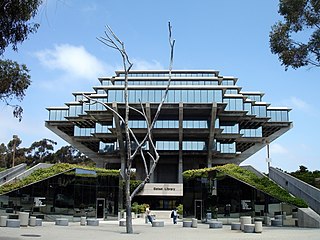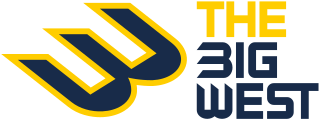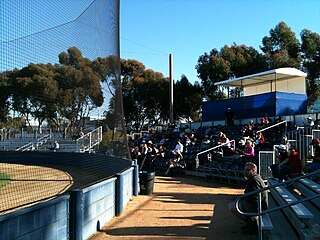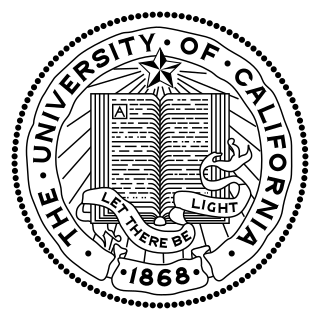
The University of California, San Diego is a public land-grant research university in La Jolla, California. Established in 1960 near the pre-existing Scripps Institution of Oceanography, UC San Diego is the southernmost of the ten campuses of the University of California, and offers over 200 undergraduate and graduate degree programs, enrolling 33,096 undergraduate and 9,872 graduate students. The university occupies 2,178 acres (881 ha) near the coast of the Pacific Ocean, with the main campus resting on approximately 1,152 acres (466 ha). UC San Diego is ranked among the best universities in the world by major college and university rankings.

Sixth College is the sixth and second-newest college of the University of California, San Diego. It was established in September 2001. Sixth College's core writing program, Culture, Art and Technology (CAT), is a five-course sequence that integrates writing skills into multidisciplinary classes to examine the intersections of culture, art, and technology.

John Muir College is one of the seven undergraduate colleges at the University of California San Diego (UCSD). The college is named after John Muir, the environmentalist and founder of the Sierra Club. It has a humanitarian emphasis focused on the "spirit of self-sufficiency and individual choice." The college opened in 1967, at the height of the American environmental movement triggered in part by Rachel Carson's book Silent Spring. John Muir College describes itself as the "Heart of UCSD" and boasts a strong and distinct character after fifty years of existence.

Revelle College is the oldest residential college at the University of California, San Diego in La Jolla, California. Founded in 1964, it is named after oceanographer and UC San Diego founder Roger Revelle. UC San Diego—along with Revelle College—was founded at the height of the Space Race between the United States and the Soviet Union. As a result, the initial class of 181 undergraduates comprised only 30 non-science majors. Revelle College focuses on developing "a well-rounded student who is intellectually skilled and prepared for competition in a complex world."
UC San Diego Health is the academic health system of the University of California, San Diego in San Diego, California. It is the only academic health system serving San Diego and has one of only two adult Level I trauma centers in the region. In operation since 1966, it comprises UC San Diego Medical Center in Hillcrest as well as Jacobs Medical Center, Moores Cancer Center, Shiley Eye Institute, Sulpizio Cardiovascular Center, and Koman Family Outpatient Pavilion, all located in La Jolla. It also includes several outpatient sites located throughout San Diego County. The health system works closely with the university's School of Medicine and Skaggs School of Pharmacy to provide training to medical and pharmacy students and advanced clinical care to patients.

The Sun God Festival is an annual campus festival at the University of California San Diego that takes place every spring quarter. The daytime festival is produced by the AS Concerts & Events office and paid for by the student body activity fee. The festival has featured a vast variety of entertaining elements since its inception, including a cross-campus fair, lounge areas, and multiple stages which have featured art performances, live comedy, student talent, DJ sets, and a mix of underground and commercially successful musical performers. All of this occurs on RIMAC Field. The main stage is traditionally opened by the winner of the Battle of the Bands, a competition that UCSD student musicians perform in leading up to the festival.

The University of California San Diego School of Medicine is the graduate medical school of the University of California, San Diego. It was the third medical school in the University of California system, after those established at UCSF and UCLA, and is the only medical school in the San Diego metropolitan area. It is closely affiliated with the medical centers that are part of UC San Diego Health.

Geisel Library is the main library building of the University of California, San Diego. It is named in honor of Audrey and Theodor Seuss Geisel. Theodor is better known as children's author Dr. Seuss. The building's distinctive architecture, described as occupying "a fascinating nexus between brutalism and futurism", has resulted in its being featured in the UC San Diego logo and becoming the most recognizable building on campus.

The Koala is a satirical comedy college paper. In its current form, it exists as two notable unaffiliated publications, with one that was distributed quarterly on the campus of University of California San Diego, and monthly on the campus of San Diego State University. The publication at UCSD was one of a handful of campus newspapers partly or entirely funded by the Associated Students of UCSD, until a decision by AS UCSD to defund all 13 student media outlets. There have been recent efforts to revitalize the original branch. SDSU's branch of The Koala at one point operated within SDSU Associated Students as a Recognized Student Organization (RSO) until that status was revoked in 2007. The original branch of The Koala was founded at UCSD in 1982, but the details of its origins are uncertain. The composition of the paper consists of artwork, articles, personals, and lists similar to David Letterman's Top Ten List.

The California Institute for Telecommunications and Information Technology (Calit2, previously Cal(IT)2), also referred to as the Qualcomm Institute (QI) at its San Diego branch, is a $400 million academic research institution jointly run by the University of California San Diego (UCSD) and the University of California, Irvine (UCI); in January 2022, plans were announced to add University of California, Riverside to the consortium. Calit2 was established in 2000 as one of the four UC Gray Davis Institutes for Science and Innovation. As a multidisciplinary research institution, it is conducting research discovering new ways in which emerging technologies can improve the state's economy and citizens' quality of life. Keeping in mind its goal of addressing large-scale societal issues, Calit2 extends beyond education and research by also focusing on the development and deployment of prototype infrastructure for testing new solutions in real-world environments. Calit2 also provides an academic research environment in which students can work alongside industry professionals to take part in conducting research and prototyping and testing new technologies.

The UC San Diego Tritons are the athletic teams that represent the University of California, San Diego. UC San Diego has 23 varsity sports teams, as well as esports teams, and offers student participation in a wide range of sports. As of July 1, 2020, all UC San Diego teams participate at the NCAA Division I (DI) level in the Big West Conference. During their time in NCAA Division II and the California Collegiate Athletic Association starting in the 2000–01 season, UC San Diego placed in the top 5 in the Division II NACDA Directors' Cup standings nine times, including three 2nd-place finishes. NCSA Athletic Recruiting ranked the Tritons as the nation's top Division II program for eight consecutive years.
The Irwin and Joan Jacobs School of Engineering is an undergraduate and graduate-level engineering school offering BS, BA, MEng, MS, MAS and PhD degrees at the University of California, San Diego in San Diego, California. The Jacobs School of Engineering is the youngest engineering school of the nation's top ten, the largest by enrollment in the University of California system, as well as the largest engineering school on the West Coast and the ninth-largest in the country. More than thirty faculty have been named members of the National Academies. The current dean of the Jacobs School of Engineering is Albert P. Pisano. The Jacobs School of Engineering sends a monthly news email which anyone can subscribe to.

Triton Ballpark is the home field of the University of California San Diego Tritons college baseball team.

Hullabaloo is an annual campus music festival at the University of California San Diego. It has been a part of the university's Founders' Celebration every November since 2011, when it was created to replace its predecessor, FallFest. There was no festival in 2020.

The Recreation, Intramural, and Athletic Complex is a sports complex at the University of California San Diego comprising an arena, a weight room and various other event and athletic facilities. It is one of the largest college athletic facilities in the country. LionTree Arena is the home arena of the UC San Diego Tritons men's and women's basketball, volleyball, and fencing teams, and Triton Soccer Stadium on the adjacent RIMAC Field hosts Triton men's and women's soccer matches.

Jacobs Medical Center is a teaching hospital on the University of California, San Diego campus in the La Jolla neighborhood of San Diego. Along with the UC San Diego Medical Center, Hillcrest, it serves as a flagship hospital of UC San Diego Health and the primary teaching hospital for the UC San Diego School of Medicine. The facility, which offers specialized care not previously available in San Diego County, opened in 2016.

Canyonview Aquatic Center is the main aquatic center at the University of California San Diego, comprising two Olympic-size swimming pools, bleacher seating, and associated fitness facilities. It is located on the Warren College campus and serves as the home stadium of the Triton men's and women's water polo, swimming and diving teams.

The UC San Diego Medical Center, Hillcrest is one of two medical centers of UC San Diego Health and is a teaching hospital for the University of California San Diego School of Medicine.

The Compton Cookout was an off-campus event hosted by several University of California, San Diego (UCSD) students and organized by several fraternities February 15, 2010. The party, which gained national attention, was intended to mock and ridicule Black History Month. Attendees were invited to wear costumes that stereotyped minorities living in ghettos, particularly African Americans. The event was widely criticized and was followed by several racially charged chalk graffiti incidents targeting specific ethnic and minority groups, eventually earning Winter Quarter 2010 the dubious nickname of "Black Winter."























